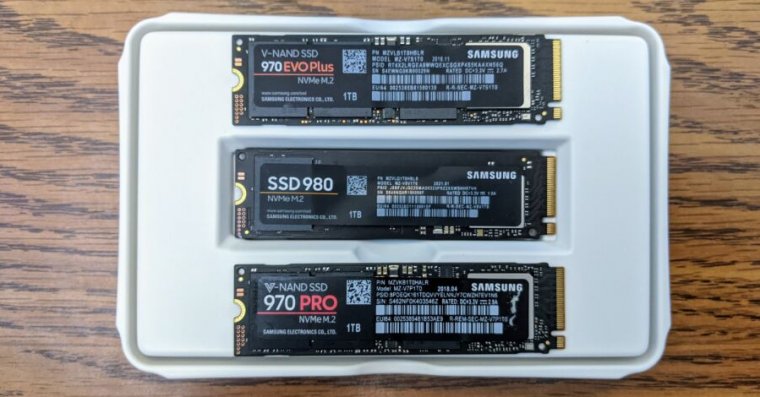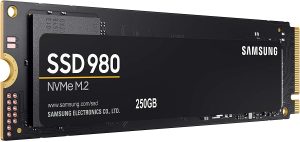
Samsung's newest generation of midgrade consumer NVMe storage is out today—the new drive is simply dubbed the "Samsung 980," without any suffix. The reviewer guide Samsung provided us compares the new drive to last generation's 970 EVO—we didn't have a 970 EVO on hand, but we did have a 970 EVO Plus and a 970 Pro, so those are the prior-generation drives we'll compare the new 980 to today.
A TLC drive by any other name

Samsung 980 SSD
| Designation | bits per cell | Discrete voltage levels |
| SLC | 1 bit | 2 |
| MLC | 2 bits | 4 |
| TLC | 3 bits | 8 |
| QLC | 4 bits | 16 |
Samsung calls the 980 a "three bit MLC" SSD, which is a lot like referring to a red car as "pink." To justify this, the company leans on the fact that "M" stands for "Multi"—so in plain English, "three bit MLC" could make sense, despite being utter nonsense in the established terminology of SSDs. From here on out, we're going to call it what it is: TLC.
As the data density of NAND cells goes up, their speed and write endurance decreases—it takes more time and effort to read or write one of eight discrete voltage levels to a cell than it does to get or set a simple, unambiguous on/off value.
To a certain degree, this disadvantage can be overcome with parallelism—by splitting the same 1MiB write between eight banks of NAND, you can get much lower latency and higher throughput than you would if the entire 1MiB had to be written to a single bank. This is the major reason that even within the same SSD model, larger capacity SSDs are almost always faster than smaller ones.
A larger, more dynamic SLC cache
In order to accelerate writes beyond that, you need a faster buffer area—which you can get simply by configuring part of your NAND as faster-moving, higher-endurance SLC. The physical media doesn't really need to be different; your SSD controller simply needs to know to treat it that way.
In earlier versions of Samsung SSDs, the SLC buffer area was fixed—but beginning with the 960 EVO, Samsung controllers introduced what it brands "Intelligent" Turbowrite, which is a dynamic amount of SLC buffer configurable by the controller itself. In the 960 EVO and 970 EVO, the "Intelligent" buffer area was a subset of the total SLC cache—the 980 introduces a much larger and, for the first time, entirely dynamic SLC cache.
| Capacity | 970 EVO | 980 | ||||
| Total SLC cache | Static SLC cache | Dynamic SLC cache | Total SLC cache | Static SLC cache | Dynamic SLC cache | |
| 250GB | 13GB | 4GB | 9GB | 45GB | 0GB | 45GB |
| 500GB | 22GB | 4GB | 18GB | 122GB | 0GB | 122GB |
| 1TB | 42GB | 6GB | 36GB | 160GB | 0GB | 160GB |
This enormous (3.5x to 5.5x) increase in fast cache area means that relatively empty 980 SSDs can significantly outperform earlier Samsung EVO models, delaying the point at which a user "falls off the write cliff" for much longer. The impact of "falling off the cliff" is worse for smaller drives—but even with the 1TB model, this means cutting top speeds by as much as three quarters.
Samsung's improvements here don't make the write cliff go away—if you write more than the maximum SLC cache amount without giving the drive a few moments to breathe, performance will still plummet. But the greatly increased delay before it hits is a welcome change.
Performance
-
All tests in this chart are with 1MiB blocksize—this is performance similar to what you'd get reading or writing very large single files.Jim Salter
-
These 4KiB blocksize charts demonstrate the drives' worst-case performance—reading or writing lots and lots of very tiny files.Jim Salter
Samsung's reviewers guide pits the new 980 versus last generation's 970 EVO. Unfortunately, we didn't have a 1TB 970 EVO on hand—but we did have a 1TB 970 EVO Plus and a 1TB 970 Pro. Unsurprisingly, the new 980 falls for the most part in between last generation's EVO Plus and Pro.
The 970 Pro does not use an SLC cache at all and therefore doesn't fall from the same "write cliff" that the 980 eventually does. In the longest-running test above—the 1MiB random write, which we ran using fio rather than CrystalDiskMark like the others—this gives the 970 Pro a chance to start running cleanly away from the 980 before the test ends.
The 980 is significantly faster than the 970 EVO Plus in both random and sequential 1MiB blocksize workloads—but the increase doesn't really address users where the pain lives. When we move down to 4KiB workloads, there's little to choose from between any of these drives.
In other words, when your drive is making big fat numbers to make you happy, the 980 makes them bigger and happier than its predecessor. But if you're hoping a nice new drive will fix your slow copying problems, you're probably out of luck—the 980 is neither worse nor better than other recent Samsung NVMe drives.
Price
The MSRP on the Samsung 980 has taken a sharp turn downward, likely due in large part to its DRAM-less (and therefore less expensive to manufacture) design.
As of publication time, real-world retail pricing on Samsung 970 EVO Plus runs $60, $80, and $160 for its 250GB, 500GB, and 1TB models. We haven't seen real-world pricing on the Samsung 980 yet, but its MSRP is considerably lower—particularly for the larger model—at $50, $70, and $130 respectively.
The big price drop on the 1TB model makes the argument to "buy large" even stronger. Even if you only have a little data, bigger drives are faster, have higher write endurance, and have more consistent performance. The $80 price difference between a 250GB Samsung 980 and its 1TB big sibling is a worthwhile investment—especially if you want to use the same drive at peak performance for 5+ years.
Conclusions
Samsung's new 980 is a fine midgrade consumer drive. With a drastically increased SLC write buffer area, it can provide more consistent high performance and for longer than earlier generations. It's still no Pro-level drive—if you write tons of data to your SSD for long periods at a time, you should still be looking to spend more on a design that doesn't lean on SLC cache in the first place. But most consumers—including gamers—won't fall into this category.
On the other hand, size continues to matter—the larger the SSD you buy, the more write endurance and fast cache you get along with the increased capacity. Even if you only have 200GiB of data, the extra muscle that comes along with a 1TB SSD is well worth the additional cost.
The Good
- More consistent extended performance than 970 EVO Plus
- Higher maximum performance than 970 EVO Plus
- Lower cost than 970 EVO Plus makes bigger SSDs more affordable
- Updated thermal design for increased reliability
The Bad
- Ever-shifting consumer branding—EVO, EVO Plus, non-EVO, Pro. We're waiting for "Samsung 9000 Blackwatch Plaid"
- Stop trying to make "three-bit MLC" happen, Samsung!
The Ugly
- It's still not a Pro
reader comments
111